Tanks, fields and peanuts: Vickers Shervick heavy tractor
As is known, despite all the efforts of agriculture and food industry, the UK faced problems in terms of food supply until the end of World War II and in the first post-war years. To solve these problems, various ideas were proposed and implemented, one of which was the reason for the development of an interesting sample of multi-purpose technology suitable for use in construction and agriculture.
Among other things, the British needed enough dietary fat. This problem was proposed to be solved by growing peanuts and then obtaining peanut butter. The cultivated plant was planned to be planted on the territory of Tanganyika (now the continental part of Tanzania), which at that time belonged to Great Britain. Growing up a new crop in Africa, it was thought, made it possible to reduce the burden on the British fields and solve food problems more quickly.
According to the calculations of the authors of the new program, under the cultivation of peanuts in Tanganyika it was possible to allocate fields of 150 thousand acres - 60700 hectares or 607 square. km However, at that time, the future fields were occupied by various wild vegetation, which was first needed to be removed. In addition, the selected area should be leveled. To solve such problems, agriculture needed heavy tracked tractors and bulldozers with high characteristics, which at the time were a real deficit.
In the 1946-47 years, the British authorities managed to find a certain amount of conditionally free equipment and send it to Africa to build new lands. However, scarce cars continued to work for too long. Poorly trained machinists and mechanics could not cope with the operation of the equipment obtained, and therefore, by the beginning of the autumn of 1947, two thirds of the park was idle due to breakdowns and the impossibility of immediate repair. The peanut growing program for the metropolis is under threat.
In the same year, 1947, in the context of an important agricultural program, a new idea emerged, which made it possible to get the necessary numbers of tractors and bulldozers in reasonable time. Vickers Armstrong, which had previously participated in the construction of armored combat vehicles of various classes, proposed rebuilding existing tanks into agricultural equipment. During this period, the British army was actively writing off excess tanks and armored vehicles, and therefore the production of tractors did not risk being left without "raw materials." Responsible persons studied the proposal and determined that its implementation allows to solve the tasks with minimal cost. Soon, the initiative company received an official order to develop a heavy-duty multi-functional tractor.
The project of a tracked agricultural machine involved the use of components and assemblies of existing production tanks M4A2 Sherman. Such combat vehicles were in service with the British army, but gradually were written off in connection with the end of the war. The choice of the base tank was reflected in the name of the project. The tractor was called Shervick - from Sherman and Vickers. Other designations, as far as is known, were not used.
The easiest way to rework a tank into a tractor is to remove the turret and various equipment associated with solving combat missions. Nevertheless, the simple M4 tank chassis without a tower did not fully meet the requirements for new agricultural equipment. To obtain the desired results and special characteristics of the existing machine had to be significantly reworked. The design of the hull and superstructure, power plant, etc. has changed. The most serious improvements underwent habitable compartments.
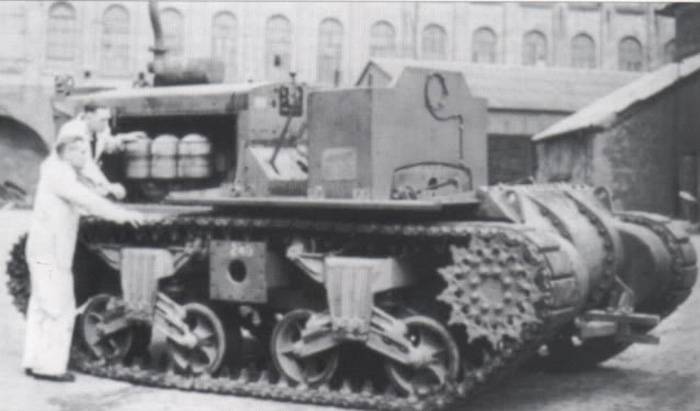
One of the serial "Shervikov" view of the left side. Photo Shushpanzer-ru.livejournal.com
The Sherman tank was too big and heavy to use as a tractor. For this reason, the project "Schervik" provided for the abandonment of the existing building in the original configuration. Instead, it was necessary to use a new welded steel unit of a special design. As a result, the new tractor lost its resemblance to the base tank, and now only a few chassis and hull units issued its origin.
The basis of the new building was a metal "bath" of reduced size. Its front part received a vertical bottom sheet connected to the front inclined section of the bottom. On the sides of them were vertical sides. The aft section of the hull was formed by the cast armor cover of the transmission, initially the former lower frontal part of the Sherman tank. Inside a relatively light body, made mostly of structural steel, several power elements were placed. The structure of such a frame included a crossbeam for mounting dozer equipment. Its ends were located in the center of the sides and out through the chassis.
In front of the hull placed the engine, covered with a light casing "tractor" type. Its front wall had a large grille for the radiator, and on the side and on top the engine compartment was covered with panels with ventilation openings. Directly behind the engine placed an open cockpit. All instruments and controls were located on the rear wall of the engine compartment. The simplest seat of the tractor installed inside the U-shaped case. For more convenience, landing and disembarking on the sides of the cabin were small fenders.
According to known data, the Shervick tractor retained the power plant and transmission of the M4A2 serial tank, but the placement of these units has changed. In front of the hull, under the cover, were placed two diesel engines General Motors 6-71. The engine rotated the driveshaft, which passed through the internal compartment of the hull and connected it to the aft transmission units. The latter were responsible for driving the stern drive wheels. Thus, the units of the tank actually turned backwards. The muffler and the exhaust pipe of the engine were on the bonnet roof, increasing the similarity with other tractors.
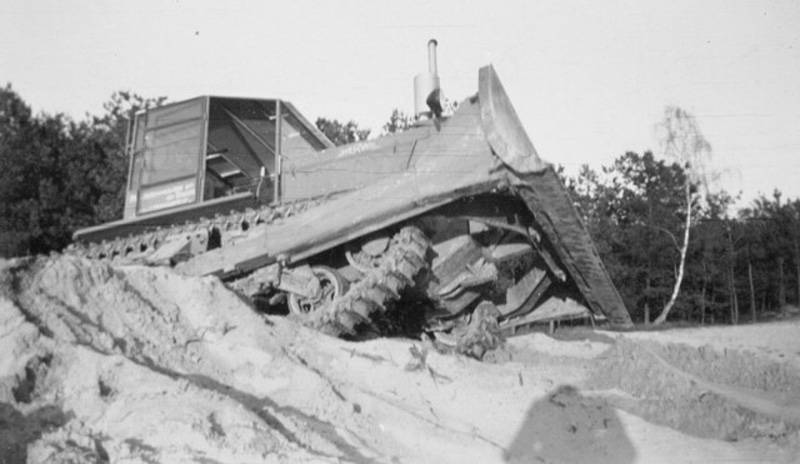
Tractor in the configuration of the bulldozer. Photo Shushpanzer-ru.livejournal.com
The undercarriage of the Shervik tractor was built on standard trolleys of a Sherman tank with a VVSS-type suspension, which had a vertical spring. On each board mounted two carts with a pair of road wheels on each. The carts also turned backwards, with the result that the upper support rollers were in front of their bodies. Between the carriages on board the hull, the ends of the transverse beam with the dozens of dozer equipment were removed. In front of the “deployed” chassis were standard guide wheels, in the stern - leading. The caterpillar remained the same, but it was shortened in a noticeable way.
A promising multi-purpose tractor, as conceived by its creators, could solve various tasks, but first of all it was to be the carrier of the dozer and earth-moving equipment. It was this role that was taken into account in the design of the chassis, which received a special frame with the power elements brought out on the sides.
For the installation of additional equipment for a particular purpose, it was possible to use a transverse beam or new fastenings placed on the cast housing of the transmission. The beam was intended for a dozer blade, whereas behind the tractor any towed equipment could be attached to the tractor.
It is known about the creation of several options for attachments specifically for new tractors. In the simplest form, bulldozer equipment was used. It was a heap on the longitudinal beams. The blade was fixed at the required height using a rigid connection with the machine body.
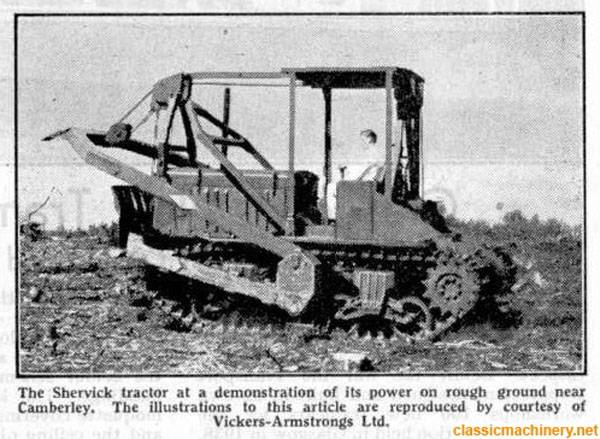
Tests of the korchevalny equipment. Photo Classicmachinery.net
Roofing equipment designed specifically for the Shervick bulldozer was also tested. In this case, a complex structure of several frames and a full roof was placed over the hood and cab. The system, in turn, was fixed on the crossbeam with a pair of additional frames, including a blade. The movement of the working body and the uprooting of stones or stumps was carried out with the help of a winch and a cable stretched over a system of blocks.
In fact, much of the construction of the tractor "Schervik" was created from scratch. In addition, he did not need the armor of a base tank. Due to all this, it was possible to reduce the size and reduce the weight of the structure. The crawler tractor of the new type had a total length of 15 feet (4,6 m) with a width of 9 feet (less than 2,8 m). The machine's own weight was 15,25 t. After installing the target equipment, the tractor weighed 18,75 t. The maximum speed of such a machine was determined in 7,5 miles per hour (12 km / h). At the same time, a significant increase in thrust ratio in comparison with the base tank made it possible to effectively solve new tasks.
Having completed the design work, Vickers Armstrong began to assemble the first new type of tractors. For their construction, she ordered from the Ministry of Defense several M4A2 tanks, units of which were soon to be installed on equipment for earthmoving and agricultural work. The necessary hull elements, engines, transmission and chassis components were removed from the tanks. At the same time, the assembly of completely new units was required, but on the whole the construction of tractors was not particularly difficult and was not excessively expensive.
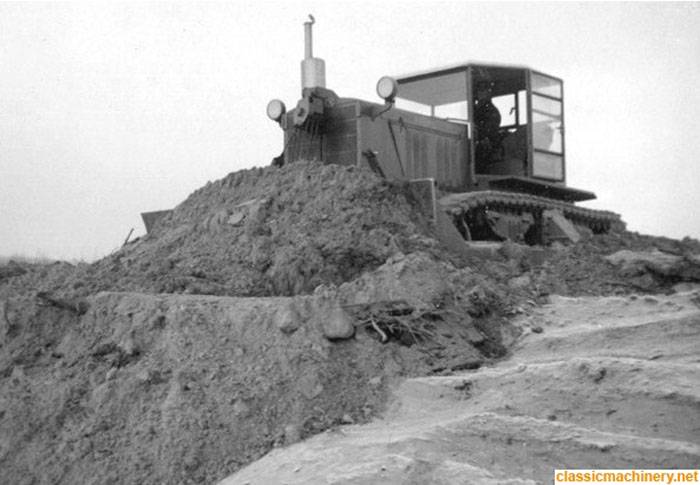
Vickers Shervick at work in the Netherlands. Photo Classicmachinery.net
Not later than 1948-49, the first Shervik machines were tested. It is known that they were checked on the grounds simulating the future place of work, in the configuration of a tracked chassis-towing vehicle, bulldozer and lifter. In all cases, the characteristics of such machines were at least as good as those of similar equipment of that time. In general, new heavy tractors were of interest for construction and agricultural organizations. They could be used not only in Africa, but also in other areas, not only for preparing peanut fields, but also in other projects.
However, the existing plans could not be fully implemented. The fact is, soon after the start of testing new technology, the harshest news came from Tanganyika. Small areas, already cleared for planting crops, have shown the senselessness of the entire project. A few months after harvesting wild vegetation and test plantings, they were not like fertile fields, but like deserts. The sun literally burned the earth, and it rained extremely rarely. As a result, the selected 150 thousand acres were not suitable for growing peanuts on an industrial scale. It was impossible to use them for other cultures unsuitable for such difficult conditions.
Messages from Tanganyika negatively affected the Vickers Shervick tank project. This machine was created specifically for work in Africa, but now its real prospects are in question. However, before making the final decision on tractors, the authorities should have decided on the future ambitious program for growing peanuts and supplying the population with edible fats. Disputes at different levels took a lot of time, and only at the beginning of 1951, did official London decide to curtail all work in this direction. By this time, almost 50 million pounds had been spent on a major program without any return.
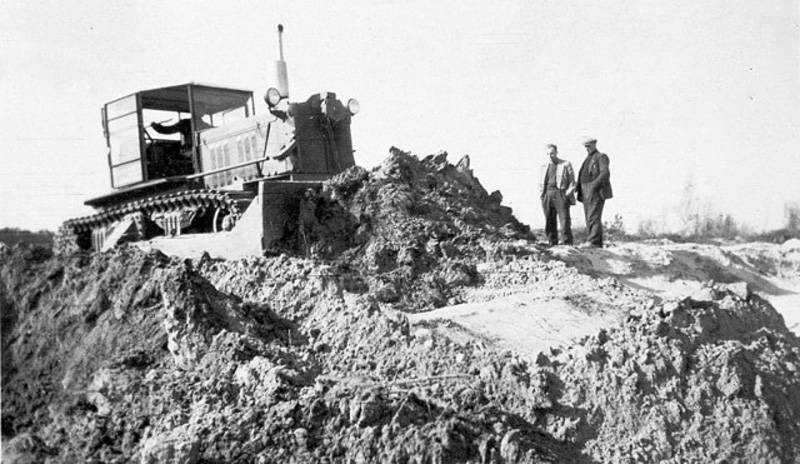
Former tanks have made a significant contribution to the restoration of hydraulic objects. Photo Shushpanzer-ru.livejournal.com
By the time such a decision was made, Vickers-Armstrong had managed to assemble several serial heavy tractors of a new type. The equipment was ready for shipment to future fields, but the customer refused to buy it. British merchants had to look for a new customer interested in obtaining such a special technique. Fortunately, it did not take long.
Several serial tractors "Shervik" were acquired by the Netherlands. At the beginning of the 1950s, a large-scale program for the repair and renovation of dams and other hydraulic structures damaged during the recent war was implemented in this country. Tank-based tractors were used in such works in the bulldozer configuration. Dutch builders exploited the received equipment for a long time. Later, as the resource was developed, a few Shervick were replaced with more new equipment. Interestingly, during the execution of an international treaty, the technician received light glazed cabins.
According to known data, in total in the late forties, Vickers Armstrong gathered no more than a few dozen new tractors. At the same time, according to some sources, their total number can be noticeably less. The original order, which provided for the shipment of equipment to Tanganyika, was canceled, and therefore it was not fully fulfilled. Subsequently, the manufacturer had to look for new buyers. Information about any new contracts, with the exception of the Netherlands, no.
There is reason to believe that some of the collected tractors were still able to be sold to commercial or state organizations. However, now it was only about the sale of "stock balance". Before the failure of the government structures, the company-developer managed to build a certain number of tractors, and it was not planned to keep them. In addition, we can not exclude that a certain proportion of "Shervikov" was dismantled as useless. In the end, units for tanks M4A2 could be sold to third mills and not as part of full-fledged complete machines.
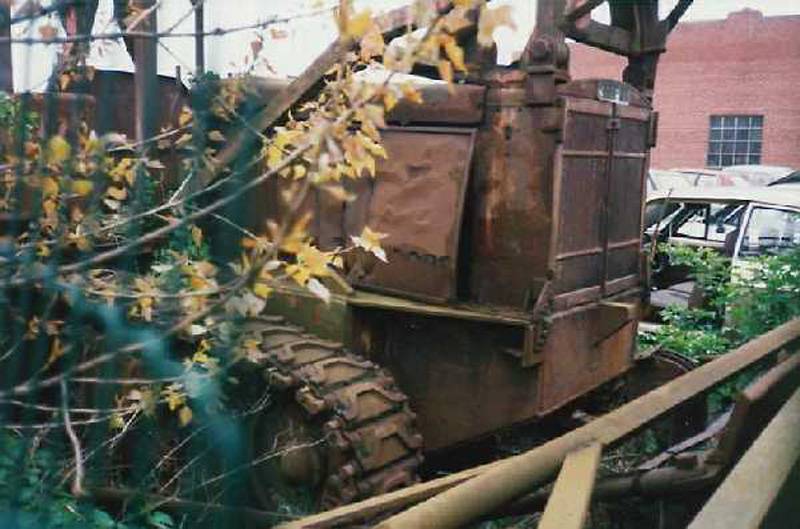
The remains of the last of the famous "Shervik", the middle of the 90-s. Photo Shushpanzer-ru.livejournal.com
As far as is known, all built Vickers Shervick tractors over time were disposed of. The last of these after years of downtime and obscurity was found in Belgium in 1995. This machine carried the lifting equipment and has long been decommissioned. Unfortunately, no one is interested in a unique machine, and therefore a sad fate awaited her. At the beginning of the last decade, the only known sample of "Shervik" was disposed of as unnecessary.
After the end of World War II, a significant number of tanks no longer needed were converted into the necessary type of equipment. The Vickers Shervik project used such principles, although it did not mean rebuilding the finished tank, but building a new car from existing units. From the point of view of mass production, he had quite large prospects and could be of interest for some customers.
Nevertheless, the Shervik tractor was designed specifically for a specific agricultural program. The rejection of plans to grow peanuts in Africa hit the project of special equipment and did not allow him to fully show their potential. The original tractors based on the M4A2 Sherman still reached full operation, but their small number did not allow to show outstanding results. However, the Shervick project remained in stories as a curious option of turning military equipment into civilian.
On the materials of the sites:
https://farmcollector.com/
http://tanks-encyclopedia.com/
http://classicmachinery.net/
https://shushpanzer-ru.livejournal.com/
http://strangernn.livejournal.com/
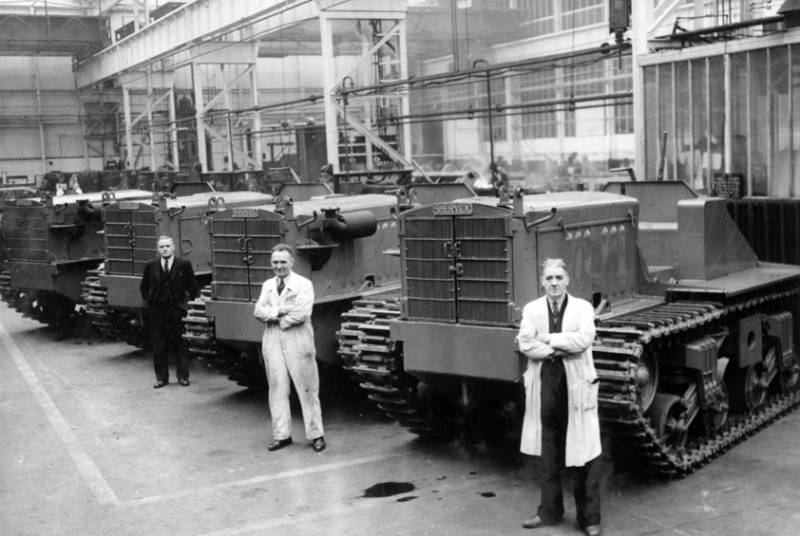
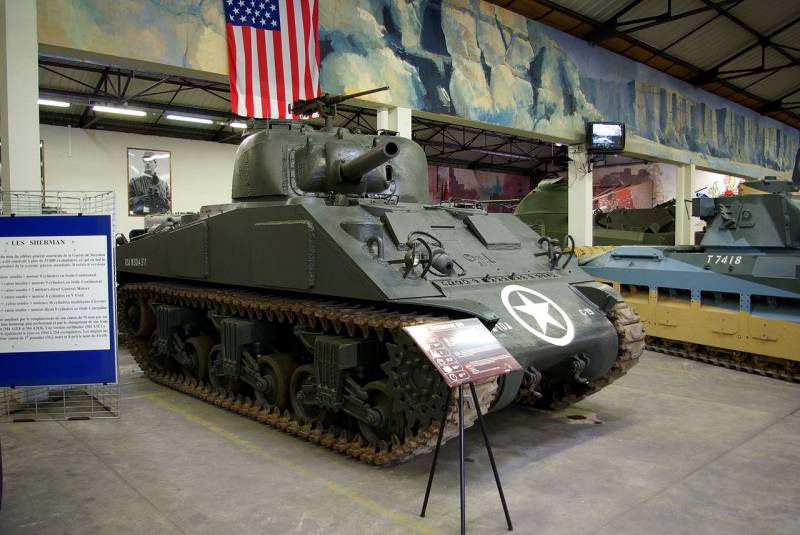
Information